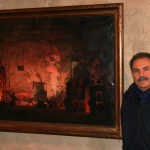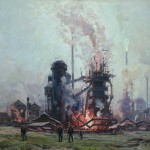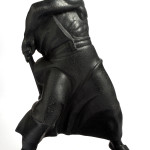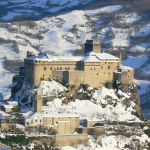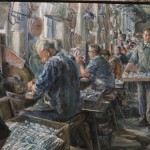A large collection of Socialist Realism artistic works will soon be on display at the Bardi castle, in the province of Parma. When art intended to glorify the worker
“It was 1995. I had opened my company in Prague a few years before, and for some time, I had taken up buying artistic objects and antiques: I started with postcards and then went on to paintings”. It was in a second-hand dealershop in Prague, oppressed for decades by communism, that the Ferrarini-Nicoli collection story began, in an antik cellar in Korunní street. Vittorio Ferrarini recalls: “As I often did then, one day I went out searching for a few art objects to buy. My painstaking research led me straight into the basement of an antiques dealer who, reluctantly and almost with a certain amount of contempt, started dusting a large 1937 canvas right in front of my eyes: a painting signed by the artist Josef Štolovský, that depicted the interior of a foundry. I had never seen anything like it before, and it struck me as a revelation”. Štolovský’s painting is a glimpse into the “inflamed bowels” of a Czechoslovak factory: the workers, as moving shadows, are standing around and in front of the machines and furnaces that emerge from the dark background. The painting is as incandescent as the molten material. It is this magmatic image of a heavy industry that inaugurates the Ferrarini-Nicoli collection, a unique set of works of art, that twenty years later, consist of 150 paintings, 40 sculptures and 50 posters. The theme is focuses on labour. From the factories to the fields, passing through the mines, the artists bear witness to the hardship and nobility of man’s activity. Several works in this collection were painted during the so-called “Socialist Realism” period, between 1948 and 1958, that from an artistic point of view, lasted until the late 1970s. A painful period for Czechoslovakia: that of the Communist regime. Decades in which art was subject to State ideology, and whose inspiration for the subjects and their treatment arrived directly from the Soviet Union. And Soviet is also the harsh and vaporous greyness that envelopes certain structures and factories depicted in the paintings: consider the Cement Works by August Bedřich Tkaczyk in 1950 or the Construction of the Prague stadium by Adolf A. Zahel of 1954. Giovanni Sciola, director of the Italian Institute of Culture in Prague explains that in that period, “according to the dictates of Marxism, art had to be accessible to the masses and play a real social role. Its main function: to bring artistic expression closer to the culture of the proletarian classes and celebrate socialist progress”.
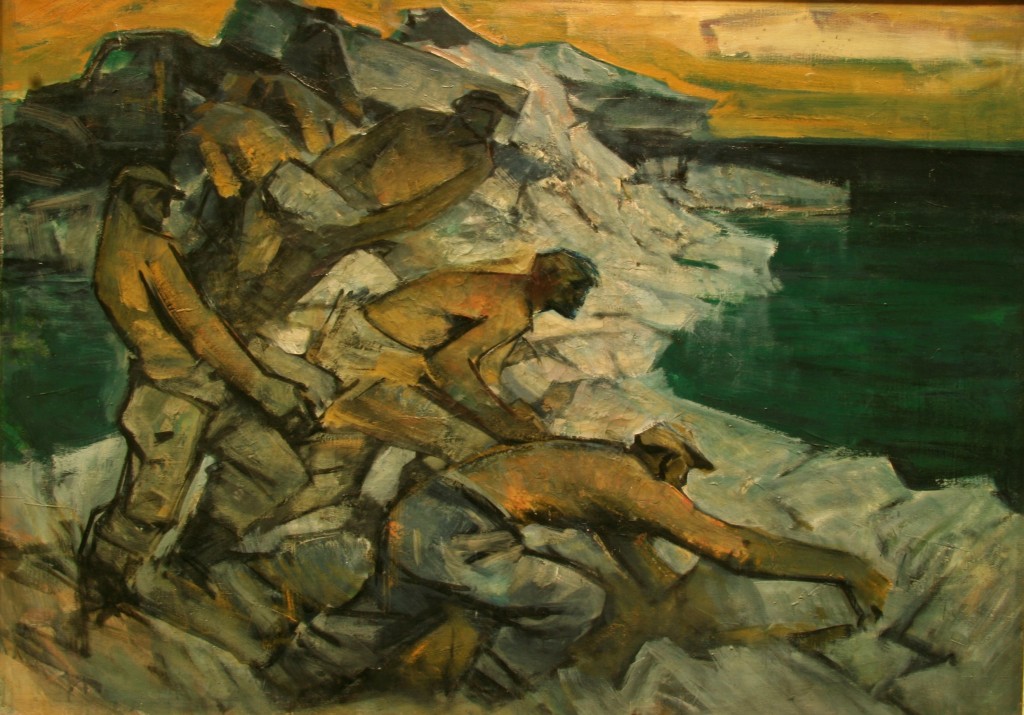 Everything had to appear as a celebration of the worker: the factory worker, the farmer and the miner are all archetypes, “workers” that are useful in representing a new efficient and Sovietized society. The Ferrarini-Nicoli collection prevented a good number of these works from being lost. Vittorio Ferrarini recalls: “Many of these types of artistic works, paintings, sculptures and posters were destroyed by the population after the fall of the Berlin Wall, and during the subsequent departure of the Russians from Czechoslovak territory. It was a spontaneous reaction, a sort of desire to do away with a long and sad period of their lives. Years spent under a regime and dictatorship. Those who were in Czechoslovakia during that period, between 1989 and 1990, told me it was quite easy to find this type of paintings and sculptures that had been thrown away by the side of the road”.
Everything had to appear as a celebration of the worker: the factory worker, the farmer and the miner are all archetypes, “workers” that are useful in representing a new efficient and Sovietized society. The Ferrarini-Nicoli collection prevented a good number of these works from being lost. Vittorio Ferrarini recalls: “Many of these types of artistic works, paintings, sculptures and posters were destroyed by the population after the fall of the Berlin Wall, and during the subsequent departure of the Russians from Czechoslovak territory. It was a spontaneous reaction, a sort of desire to do away with a long and sad period of their lives. Years spent under a regime and dictatorship. Those who were in Czechoslovakia during that period, between 1989 and 1990, told me it was quite easy to find this type of paintings and sculptures that had been thrown away by the side of the road”.
And it is also for this reason that the collector does not conceal his pride in front of these works from the past that he was able to find. Aware that he has preserved a fragment of contemporary history, Ferrarini is also conscious of the painful historical reality that produced this kind of art “perhaps it is still too painful and close in time for those who have personally experienced it”, such as Oldřich Lomecký, the municipal mayor of Prague 1 who – to the word art – prefers the expression “artistic perversion” and remembers how, on the homeland, the art of Socialist Realism was contemptuously referred to as “sorela” or “socrel”, the initials to the Czech words socialistický realismus. Behind the utopia of these works lies a very different reality: made of deprivation and lack of freedom. However, Lomecký acknowledges the merit of this important collection: a historical memory, or rather a sort of warning to make sure this contemporary period of Czechoslovak history does not repeat itself a second time.
Political considerations aside, it should be remembered that not all of these paintings and sculptures belong to the communist era and that they speak primarily of man’s toil in rural and industrialized cities. In the stone quarries by Jaromír Schoř, the characters seem carved in the material they are working on: their bodies are broken lines that identify them to the extraction material, which they move with great effort. There is the outstanding The Founder by Jan Václavík (1922), where the worker is a concentration of force lines that stretch brightly coloured spots. Josef Štolovský, with his foundries and factory workers involved in the melting process, reveal the “boiling bowels” of heavy industries. However, there is a host of other artists that preferred to explore agricultural work: among them are Václav Trefil, Vojtěch Hynek Popelka or Alena Čermáková, the only woman artist in the collection. If rural work is a subject that has already been explored by various prestigious artists in the nineteenth century, it is sufficient to consider several paintings signed by Gustave Courbet. This theme is also closely bound to the biography of Vittorio Ferrarini, who from the beginning, searched for and bought “almost obsessively” paintings depicting the subject of labour. “I have always painted it. I have always painted farm landscapes and the land. My parents were farmers, and until my graduation, I used to work on the fields. I shared with them the hard work of the fields and this feeling must have had a strong influence on me – and that is why I went on to collect these works of art”.
What is sure is that this art and this collection has, over the years, gone beyond the horizons of a personal quest and have become an established reference for this type of Czechoslovak artistic expression. The Parma collector explains: “In recent years there has been a significant revaluation of these works and of their authors, both from a pictorial and historical point of view. In fact, since the beginning of the year 2000, various exhibitions have been held in Prague, as well as in Italy, thus confirming the growing interest that this type of painting has sparked. The first was in 2002 at the Rudolfinum Theatre in Prague. The exhibition was entitled “Czechoslovak Socialist Realism”. In 2012, in Udine at Villa Manin, again with the title “Czechoslovak Socialist Realism”. In Mantua in 2015, at Mantegna’s house, “Socialist Realism” by a single author, Jaromír Schoř, where five works were exhibited from a lent collection”. But the latest project, in order of time, is even more ambitious: “A permanent exhibition at the Bardi castle in the province of Parma, that will open at the end of March, early April 2017. The installation includes 60 paintings and 16 statues in a place that sees almost thirty thousand visitors a year”. The place, thinking back to the words of Ferrarini, has a profound harmony with the collection that will take place there. The fields around, the agricultural land, are the symbolic places of man’s toil, the unique and deep motive of the Ferrarini-Nicoli collection.
by Edoardo Malvenuti





